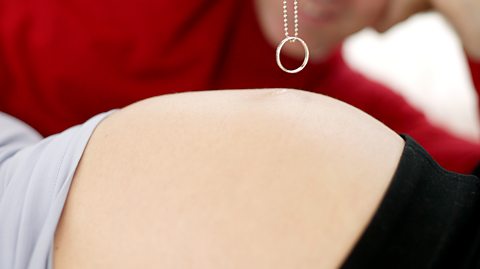
Gender-reveal parties have swept across social media feeds in the past couple of years, but trying to guess whether you’re having a boy or a girl is nothing new.
Before a scan could reveal which filling is right for the colour-coded cake, people have tried different methods to predict the sex of a baby ahead of birth for possibly thousands of years. These include some pretty weird and wacky games of guess-who, from listening to gold rings to peeing on plants. Were they accurate? Not really, but some have stuck around.
Here are six strange sex-guessing myths that you might still hear today – but none of them are scientifically sound, so take them with a pinch of salt.
Sugar, spice, all things nice: Food cravings
Or should that be a lump of sugar?
While pregnancy cravings are normal, plenty of food myths around baby boys and baby girls have come about because of them. For example, a common old wives’ tale claimed that if the pregnant person craved sugar, they would be having a sweet little girl. In contrast, savoury, sour or spicy foods meant a little boy was on the way.
However, cravings are more likely to be caused by hormonal changes, a heightened sense of smell or mineral deficiencies - and none of these are exclusive to pregnancy.
One thing to be cautious of - if mum is craving non-edible things, it could be a sign of an iron deficiency and a sign she should speak to her GP.
Higher or lower: Baby bump shapes
A belief that persists today is that you can tell the sex of a baby from the shape of the mother’s belly.
You might have heard about people carrying “low”, meaning a bump closer to the hips, which is meant to indicate they’re due a baby girl. Or otherwise, they might be carrying “high”, meaning a lifted, protruding bump, which supposedly leads to a boy being born. Or vice versa, depending on who you're talking to! Similar myths include carrying “wide” for a girl, or “narrow” for a boy, looking at the horizontal shape of the bump.
While these shapes might give a clue to which position a baby is floating in, it has nothing to do with the sex. The bump myths might have come from stories of families with multiple children – because the abdominal muscles in a first pregnancy tend to stretch less, this may result in a very round, high bump, whereas the muscles get looser with each pregnancy and so a second one may result in a low-hanging belly. Core strength can also play a role in this, as well as age and body type. However, babies usually “drop” in late pregnancy as they get closer to being born and turn upside-down, so even a “high” pregnancy will eventually become “low”. Naturally, someone carrying multiple babies has to accommodate with a bigger tummy!


The tell-tale heart: Speed of heartbeat
Possibly left over from Victorian society, the strength and speed of a baby’s heartbeat became associated with sex. With the invention of the stethoscope, a doctor could listen to baby’s activity inside a mother for the first time (albeit a lot later on in pregnancy than you can using today’s technology). Originally it was thought that the presence of a strong heartbeat meant an athletic boy was on the way, and a softer, slower heartbeat belonged to a delicate baby girl.
Over time, the myth seems to have been turned on its head, with the idea being that a heartbeat below 140bpm belongs to a boy. However, there’s no evidence that the heartbeat offers clues to gender. It’s more important that the heartbeat is consistent and not too fast or slow, as this is an indication of the baby’s health.
Suspension of disbelief: The pregnancy ring test
Another bit of sex-guessing folklore passed down through the generations involves suspending a gold ring (such as a wedding ring) on a string above the baby bump.
Some believe that the direction in which the ring swings can reveal what is on the way. If the ring swings from side to side, it’s a boy, or if in circles, a girl is to be expected. It’s safe to say the chances of guessing correctly with this method are about the same as flipping a coin: one study into guessing games like this found them to be less accurate than when mothers based their predictions on dreams and intuitions.

Watering plants: Early pregnancy tests
The pregnancy test most commonly used today is based on samples of urine. The earliest recorded form of urine-based pregnancy test comes from Ancient Egypt, where they thought they’d gone one better by revealing a baby’s gender too. The test was simple: pee on a handful of barley and wheat seeds every morning for a few days. If the seeds sprouted, it was a confirmed pregnancy – but if barley grew it was a girl, and if wheat grew, it was a boy.
A study conducted in 1963 replicating this test revealed it to be around 70% accurate when it came to predicting pregnancy. This is likely to be because higher levels of oestrogen in pregnant-person pee (say that six times fast) help to stimulate plant growth. However, the barley/wheat outcome was purely up to chance.
Pregnancy myths busted
In reality, a baby’s sex is only determined at the moment of conception by the sperm that happens to reach the egg. Usually, if a sperm carries a Y-chromosome, it will make a male foetus, whereas an X-chromosome will make a female foetus.
This is a random process. The only ways we can see the results prior to birth are via clinical tests such as ultrasound scans.






